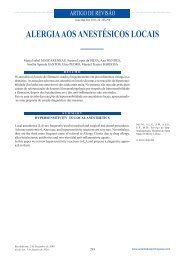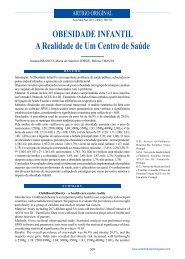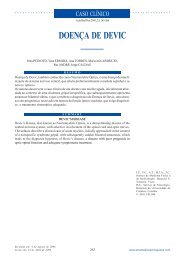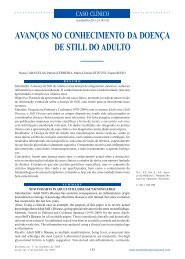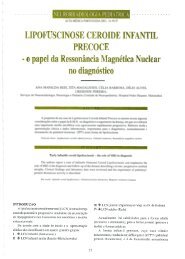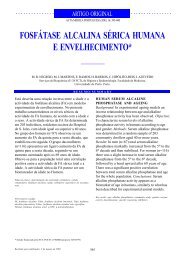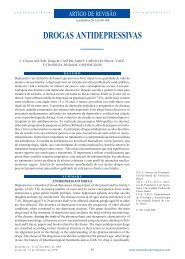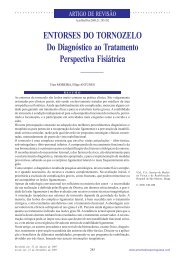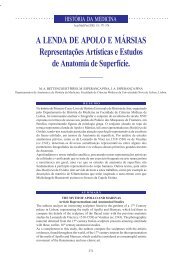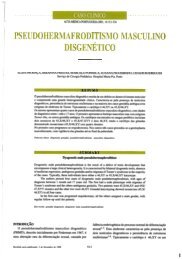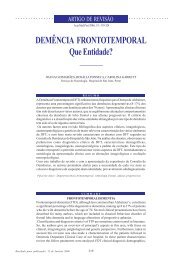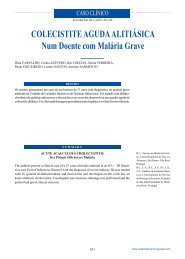abordagem da menopausa - Acta Médica Portuguesa
abordagem da menopausa - Acta Médica Portuguesa
abordagem da menopausa - Acta Médica Portuguesa
You also want an ePaper? Increase the reach of your titles
YUMPU automatically turns print PDFs into web optimized ePapers that Google loves.
Luís Filipe CAVADAS et al, Abor<strong>da</strong>gem <strong>da</strong> <strong>menopausa</strong> nos cui<strong>da</strong>dos de saúde primários, <strong>Acta</strong> Med Port. 2010; 23(2):227-236<br />
INTRODUÇÃO<br />
www.actamedicaportuguesa.com<br />
how to properly approach women at this stage of their life and how to provide them the<br />
best support.<br />
Objectives: To evaluate women in perimenopause and post<strong>menopausa</strong>l, to recognize<br />
its signs and symptoms, and to use properly the Hormone Replacement Therapy<br />
(HRT) in Primary Health Care (PHC).<br />
Methods: We performed a literature search in the PubMed <strong>da</strong>tabase using the MeSH<br />
terms: Menopause, Hormone Replacement Therapy, Primary Health Care. The search<br />
was limited to articles published between January 2000 and March 2009 in English,<br />
Portuguese and Spanish. Recommen<strong>da</strong>tions from Scientific Societies were also searched.<br />
Results: During menopause women are more predisposed to change their habits and<br />
to adopt healthy lifestyles. The GP plays a key role in health promotion among these<br />
women.<br />
The most common complaints that lead women to the PHC during perimenopause are<br />
vasomotor symptoms, sleep disorders, weight gain, uterine bleeding, urogenital and<br />
sexual changes and disturbances of mood and memory.<br />
The use of HRT is only recommended for the control of severe vasomotor symptoms<br />
that affect women’s quality of life, as well as for vaginal atrophy and urinary symptoms.<br />
It should be used for a short period of time and in the lowest dose. It is important for<br />
the GP to know the existing formulations, the way of administration and the correct<br />
monitoring of this therapy.<br />
Conclusion: Women experience physical and psychological changes during perimenopause<br />
and post<strong>menopausa</strong>l, resulting from aging and hypoestrogenism. It is<br />
essential that the GP recognizes the symptoms and their impact on quality of life of<br />
women, offering treatment when necessary. The HRT and its follow-up can be performed<br />
in PHC, if the GP know how to use this type of treatment.<br />
A Menopausa é um processo biológico que ocorre<br />
como parte do envelhecimento na mulher. O aumento <strong>da</strong><br />
esperança média de vi<strong>da</strong> e a diminuição <strong>da</strong> mortali<strong>da</strong>de<br />
têm contribuído para um envelhecimento global <strong>da</strong> população,<br />
havendo uma percentagem ca<strong>da</strong> vez maior <strong>da</strong> população<br />
feminina que se encontra em pós-<strong>menopausa</strong>. Actualmente,<br />
as mulheres viverão cerca de um terço <strong>da</strong> sua vi<strong>da</strong><br />
em pós-<strong>menopausa</strong> 1,2,3,4 .<br />
Quando se fala de <strong>menopausa</strong> é fun<strong>da</strong>mental ter<br />
em mente as seguintes definições aceites internacionalmente:<br />
Menopausa – corresponde à <strong>da</strong>ta <strong>da</strong> última menstruação<br />
em consequência de falência ovárica definitiva. O diagnóstico<br />
clínico é realizado apenas retrospectivamente depois<br />
de 12 meses consecutivos de amenorreia, que não<br />
seja explica<strong>da</strong> por outra causa patológica ou fisiológica.<br />
Não existe nenhum marcador biológico independente adequado<br />
para estabelecer este diagnóstico, sendo por isso<br />
desnecessário o doseamento seriado do estradiol ou hormona<br />
folículo-estimulante (FSH). A i<strong>da</strong>de em que ocorre a<br />
<strong>menopausa</strong> numa mulher (habitualmente entre os 45 e os<br />
55 anos) é principalmente determina<strong>da</strong> geneticamente, mas<br />
228<br />
também pode estar associa<strong>da</strong> a factores externos. Entre<br />
estes, o tabagismo é o mais conhecido 1,4 . Em média nas<br />
mulheres fumadoras a Menopausa ocorre dois anos antes.<br />
Outros factores com uma associação menos explícita<br />
incluem nulipari<strong>da</strong>de, exposição a químicos tóxicos, quimioterapia,<br />
radiação pélvica, epilepsia e tratamento de depressão.<br />
Os factores que podem atrasar o seu aparecimento<br />
incluem obesi<strong>da</strong>de, multipari<strong>da</strong>de, e alcoolismo 1 .<br />
Peri<strong>menopausa</strong> – inclui a fase imediatamente anterior<br />
à <strong>menopausa</strong> (quando se iniciam as alterações endocrinológicas,<br />
biológicas e clínicas <strong>da</strong> aproximação <strong>da</strong> <strong>menopausa</strong>)<br />
e o primeiro ano após a <strong>menopausa</strong> 1 .<br />
Menopausa Iatrogénica – cessação <strong>da</strong> menstruação<br />
como consequência <strong>da</strong> remoção cirúrgica dos ovários (com<br />
ou sem histerectomia) ou após ablação iatrogénica <strong>da</strong> função<br />
dos ovários (quimioterapia ou radiação) 1 .<br />
Pré-<strong>menopausa</strong> – inclui to<strong>da</strong> a fase reprodutiva anterior<br />
à Menopausa 1 .<br />
Pós-<strong>menopausa</strong> – denomina o período de tempo após<br />
a última menstruação 1,5 .<br />
Menopausa Precoce – quando a <strong>menopausa</strong> ocorre<br />
numa i<strong>da</strong>de menor que dois desvios padrão abaixo <strong>da</strong> i<strong>da</strong>de<br />
média de <strong>menopausa</strong> para a população. Na prática os<br />
40 anos de i<strong>da</strong>de são usados como referência 1,4,5 , abaixo



